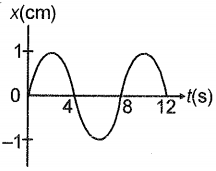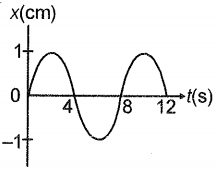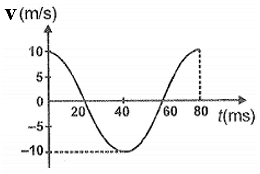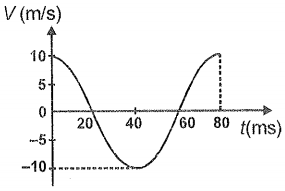The x-t graph of a particle undergoing SHM is shown below. The acceleration of the particle at is:

1.
2.
3.
4.
सरल आवर्त गति कर रहे एक कण के x - t ग्राफ को निम्नवत दर्शाया गया है। पर कण का त्वरण ज्ञात कीजिए:

1.
2.
3.
4.


Two simple pendulums of lengths 1.44 m and 1 m start S.H.M. together in the same phase. They will be in the same phase again after
1. 6 vibrations of the longer pendulum
2. 6 vibrations of the smaller pendulum
3. 5 vibrations of the smaller pendulum
4. 4 vibrations of the longer pendulum
1.44m और 1m लंबाई के दो सरल लोलक समान कला में एक-साथ सरल आवर्त गति प्रारम्भ करते हैं। वे किसके पश्चात पुनः समान कला में होगें?
1. लंबे लोलक के 6 कंपनों के पश्चात
2. छोटे लोलक के 6 कंपनों के पश्चात
3. छोटे लोलक के 5 कंपनों के पश्चात
4. लंबे लोलक के 4 कंपनों के पश्चात
The position x (in centimeter) of a simple harmonic oscillator varies with time t (in second) as . The magnitude of the maximum acceleration of the particle in is:
1. /2
2. /4
3. /2
4. /4
किसी सरल आवर्ती दोलक की स्थिति x (सेंटीमीटर में) समय t (सेकेंड में) के साथ के रूप में परिवर्तित होती है। कण के अधिकतम त्वरण का परिमाण में ज्ञात कीजिए:
1. /2
2. /4
3. /2
4. /4
Two equations of S.H.M. are and . The phase difference between the two is:
1.
2.
3.
4.
सरल आवर्त गति के दो समीकरण और हैं। दोनों के बीच कलांतर है:
1. 0°
2.
3. 90°
4. 180°
A disc is oscillating about a horizontal axis passing through its rim and perpendicular to the plane of the disc. If the radius of the disc is R, then the frequency of oscillation is
1.
2.
3.
4.
एक डिस्क इसके रिम से गुजरने वाले और डिस्क के तल के लंबवत क्षैतिज अक्ष के परितः दोलन कर रही है। यदि डिस्क की त्रिज्या R है, तब दोलन की आवृत्ति ज्ञात कीजिए:
1.
2.
3.
4.
A body of mass M is situated in a potential field. The potential energy of the body is given by ; where x is position, K and are constant. Period of small oscillations of the body will be:
1.
2.
3.
4.
M द्रव्यमान के एक पिंड को स्थितिज क्षेत्र में रखा जाता है। पिंड की स्थितिज ऊर्जा को द्वारा व्यक्त किया जाता है; जहां x स्थिति है, K और नियतांक हैं। पिंड के छोटे दोलनों का आवर्तकाल क्या होगा?
1.
2.
3.
4.
A particle executes linear oscillation such that its epoch is zero. The ratio of the magnitude of its displacement in 1st second and 2nd second is (Time period = 12 seconds)
1.
2.
3.
4.
एक कण इस प्रकार से रैखिक दोलन करता है कि इसकी अवधि शून्य है। 1 सेकेंड और 2 सेकेंड में इसके विस्थापन के परिमाण का अनुपात ज्ञात कीजिए: (आवर्तकाल = 12 सेकेंड)
1.
2.
3.
4.
The equation of simple harmonic motion is given by X = (4 cm), then maximum velocity of the particle in simple harmonic motion is:
1. 25.12 m/s
2. 25.12 cm/s
3. 12.56 m/s
4. 12.56 cm/s
सरल आवर्त गति के समीकरण को द्वारा व्यक्त किया जाता है, तब सरल आवर्त गति में कण का अधिकतम वेग ज्ञात कीजिए:
1. 25.12 m/s
2. 25.12 cm/s
3. 12.56 m/s
4. 12.56 cm/s
For a simple harmonic oscillator, a velocity-time diagram is shown. The angular frequency of oscillation is:

1. rad/s
2. rad/s
3. 25 rad/s
4. 25 rad/s
एक सरल आवर्ती दोलक के लिए, वेग-समय आरेख दर्शाया गया है। दोलन की कोणीय आवृत्ति ज्ञात कीजिए:

1. rad/s
2. rad/s
3. 25 rad/s
4. 25 rad/s
The graph between velocity and acceleration of a particle executing S.H.M. can be
1. A circle
2. An ellipse
3. A straight line
4. Both (1) & (2)
सरल आवर्त गति कर रहे कण के वेग और त्वरण के मध्य का ग्राफ है:
1. एक वृत्त
2. एक दीर्घवृत्त
3. एक सरल रेखा
4. (1) और (2) दोनों






